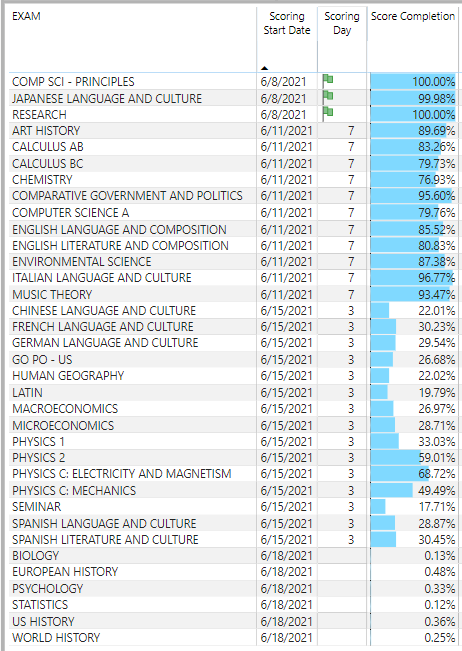The Journey to AP Score Release on July 21
As AP Exam results become available, I know some educators and students are eager for real-time information. So over the next five weeks, I’ll post here periodically to provide more detail and insight than is possible in short tweets.
This year’s AP Exam administration is finally complete: six weeks of exam dates rather than the usual two, an effort to provide students with as much flexibility as possible. (A small amount of make-up testing is still underway.) About 60% of this year’s AP Exams were taken the traditional way—in school, on paper. The rest were taken online, primarily at home.
I know students and educators can’t wait to receive scores. But before AP can release them, we need to take three big steps.
- Multiple-choice scoring. This work is complete. As expected, we’re seeing wrong answers from students who violated testing regulations by attempting to use a second device (e.g., a smartphone) to google the correct answers while taking the digital exam at home. We know this because of how the exams were designed. The college professors who wrote this year’s questions crafted them in such a way that incorrect response option(s) could include words and phrases that would appear in internet searches if a student googled key words from the question. In contrast, the correct answer to AP digital multiple-choice questions required students to apply their knowledge to a specific scenario not searchable on the internet. In other words, the right answer couldn’t be googled.
Why did college professors go to so much effort in crafting these questions? It’s simple: AP Exams must reward students for their own efforts, not the work of others. Every student who tested on paper had a proctor in the room to prevent unfair advantages. And the vast majority of students testing at home played fair, doing their own work. To protect those students, AP had to design questions that would penalize attempts to gain an unfair advantage.
In addition, some students who attempted to give or receive help by sharing their exam questions are under review. Approximately 200 students have had or will have their scores cancelled due to attempting to give or receive an unfair advantage. - Free-response scoring: the “AP Reading.” More than 22,000 professors and teachers have joined together (virtually) as AP readers. During the AP Reading, each student’s exam questions are divided among multiple faculty, ensuring every student benefits from the eyes of several experts.
At a typical Reading, readers convene at conference centers in U.S. cities to score the work together. Each reader is assigned to a table and guided by a table leader, who also back-reads the readers’ scores to confirm consistency and accuracy. This year, the process is entirely virtual, with readers assigned to virtual tables. Many of us really miss the face-to-face Reading, which will resume next summer if health conditions permit. But AP will also maintain this virtual option in most subjects for readers who simply prefer to participate from the comfort of their own homes or offices.
I’ve included the most current Reading report below, to give you a sense of how far along each subject is as of June 17 at 11:45 a.m. - Determining the “points needed” for each version of each exam.
As you’ll see in the table below, some subjects’ AP Readings are complete. So why are scores not available for another month?
Once scoring is complete, the relative difficulty of each version of each exam must be analyzed. AP exams are not normed or graded on a curve, so AP scores are never forced into a predetermined percentage of 5s, 4s, 3s, 2s, and 1s. Instead, every student who earns the required points for an AP score of 5 will receive a 5; every student who earns the required points for an AP score of 4 will receive a 4; and so on. (In theory, every student who takes an AP Exam could earn a score of 3 or higher, if every student earned the required points for such. That’s never happened, but in some subjects it’s quite close: ~82% of AP Physics C: Mechanics students, for example, earned a 3 or higher in 2019.) But the required points need to be determined separately for each and every version of an AP exam, after the exams have been scored, taking into account the difficulty of the questions that are unique to that version. More difficult exam versions require fewer correct answers; easier versions require more correct answers.
Once all AP subjects’ “points needed” have been statistically derived for each exam version, students’ AP Exam reports can be finalized and uploaded. July 21 is the date most students’ AP score reports will be complete and available online. (Some students who tested during the June exam dates will receive scores slightly later.)
***
Like many of you, I’m eager to see how students performed this year. Given the wide range of perspectives on how well students learned during the pandemic, I’m not sure what to expect. Some suggest the pandemic’s negative impact on academic schedules and learning modes will result in fewer students having learned the material necessary for college credit and placement into an upper-level college course, and that the percentage of exams earning scores of 3 or higher will thus drop significantly this year. Others believe the pandemic forced educators and students to cut extraneous material and focus on the core content and skills of each subject, helping more students learn fundamental concepts well, so this year’s exams will have a higher percentage of 3s, 4s, and 5s.
At the individual class level, I’m sure there are examples of each extreme. But in aggregate, across all AP schools? That’s tougher to predict. Time will soon tell.
***
Figure 1: AP Reading progress. Report generated June 17, 2021, at 11:45 a.m. ET.
This gives a rough sense of the order in which I’ll be able to provide the aggregated score results for each AP subject.

